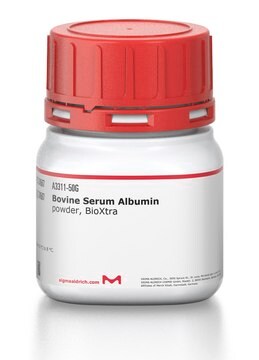A9647
Bovine Serum Albumin
heat shock fraction, pH 7, ≥98%
Synonim(y):
Albumin bovine serum, BSA, Bovine albumin
About This Item
Polecane produkty
pochodzenie biologiczne
bovine
Próba
≥98%
Formularz
lyophilized powder
masa cząsteczkowa
~66 kDa
oczyszczone przez
heat shock fractionation
pochodzenie
USA origin
metody
immunocytochemistry: suitable
zanieczyszczenia
≤5.0% Loss on drying
strata
≤5%
pH
7
rozpuszczalność
water: soluble (40 mg/ml)
numer dostępu UniProt
obecność zanieczyszczeń
BT virus, none detected
VSV virus, none detected
temp. przechowywania
2-8°C
informacje o genach
bovine ... ALB(280717)
Szukasz podobnych produktów? Odwiedź Przewodnik dotyczący porównywania produktów
Opis ogólny
Zastosowanie
- BSA has been used in cell culture, e.g. as a supplement in media prepared for culturing of oligodendrocytes.
- BSA has been used for the dilution of primary antibody solution in immunohistochemistry procedures.
- BSA has been used as a standard in the Bradford method of protein quantification.
- BSA has been used in blocking and permeabilization buffer for immunofluorescence studies.
Działania biochem./fizjol.
Uwaga dotycząca przygotowania
najczęściej kupowane z tym produktem
Kod klasy składowania
11 - Combustible Solids
Klasa zagrożenia wodnego (WGK)
WGK 1
Temperatura zapłonu (°F)
Not applicable
Temperatura zapłonu (°C)
Not applicable
Środki ochrony indywidualnej
Eyeshields, Gloves, type N95 (US)
Wybierz jedną z najnowszych wersji:
Certyfikaty analizy (CoA)
Nie widzisz odpowiedniej wersji?
Jeśli potrzebujesz konkretnej wersji, możesz wyszukać konkretny certyfikat według numeru partii lub serii.
Masz już ten produkt?
Dokumenty związane z niedawno zakupionymi produktami zostały zamieszczone w Bibliotece dokumentów.
Klienci oglądali również te produkty
Produkty
This solution is used as a substrate for detecting horseradish-peroxidase conjugates in Western blotting.
Silica monoliths with larger mesopores are a powerful tool for the fast separation of biomolecules including mAbs. The immobilization of protein A on epoxy-modified widepore (WP) silica rods enabled highly reproducible and fast, one minute, separations of mAbs. The Chromolith® WP 300 is also available with a protein A phase.
This page segues to comprehensive insights on how serum albumin and other important cell culture components affect the performance of serum-free cell culture systems used for biomanufacturing heterologous proteins including monoclonal antibodies. The page introduces the in vitro chemistry and biochemistry of albumin. These insights may also be applied to ex vivo and tissue engineering applications.
Protokoły
This procedure may be used for Alcohol Dehydrogenase products.
Use this protocol to for the entire immunohistochemistry (IHC) procedure through staining and visualization of specific antigens in paraffin-embedded tissue sections.
Protokół ten służy do przeprowadzenia całej procedury immunohistochemii (IHC) poprzez barwienie i wizualizację określonych antygenów w skrawkach tkanek zatopionych w parafinie.
Powiązane treści
Three-dimensional (3D) printing of biological tissue is rapidly becoming an integral part of tissue engineering.
Trójwymiarowe (3D) drukowanie tkanek biologicznych szybko staje się integralną częścią inżynierii tkankowej.
Nasz zespół naukowców ma doświadczenie we wszystkich obszarach badań, w tym w naukach przyrodniczych, materiałoznawstwie, syntezie chemicznej, chromatografii, analityce i wielu innych dziedzinach.
Skontaktuj się z zespołem ds. pomocy technicznej





